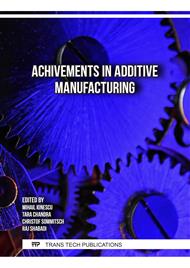[1]
A. Chakraborty, R. Tangestani, W. Muhammad, T. Sabiston, J.-P. Masse, R. Batmaz, A. Wessman, É. Martin, Micro-cracking mechanism of RENÉ 108 thin-wall components built by laser powder bed fusion additive manufacturing, Mater Today Commun. 30 (2022) 103139. https://doi.org/.
DOI: 10.1016/j.mtcomm.2022.103139
Google Scholar
[2]
Z. Li, R. Xu, Z. Zhang, I. Kucukkoc, The influence of scan length on fabricating thin-walled components in selective laser melting, Int J Mach Tools Manuf. 126 (2018) 1–12.
DOI: 10.1016/j.ijmachtools.2017.11.012
Google Scholar
[3]
X. Quelennec, E. Martin, L. Jiang, J.J. Jonas, Work hardening and kinetics of dynamic recrystallization in hot deformed austenite, in: J Phys Conf Ser, IOP Publishing, 2010: p.12082.
DOI: 10.1088/1742-6596/240/1/012082
Google Scholar
[4]
A. Chakraborty, R. Tangestani, T. Sabiston, N. Krutz, L. Yuan, É. Martin, Effect of Build Height on Micro-cracking of Additively Manufactured Superalloy RENÉ 108 Thin-Wall Components BT - TMS 2022 151st Annual Meeting & Exhibition Supplemental Proceedings, in: Springer International Publishing, Cham, 2022: p.985–993.
DOI: 10.1007/978-3-030-92381-5_94
Google Scholar
[5]
S. Catchpole-Smith, N. Aboulkhair, L. Parry, C. Tuck, I.A. Ashcroft, A. Clare, Fractal scan strategies for selective laser melting of 'unweldable'nickel superalloys, Addit Manuf. 15 (2017) 113–122.
DOI: 10.1016/j.addma.2017.02.002
Google Scholar
[6]
Y. Li, A. Olmedilla, M. Založnik, J. Zollinger, L. Dembinski, A. Mathieu, Solidification microstructure during selective laser melting of Ni based superalloy: experiment and mesoscopic modelling, in: IOP Conf Ser Mater Sci Eng, IOP Publishing, 2019: p.12004.
DOI: 10.1088/1757-899x/529/1/012004
Google Scholar
[7]
M. Gouge, E. Denlinger, J. Irwin, C. Li, P. Michaleris, Experimental Validation of Thermo-mechanical Part-Scale Modeling for Laser Powder Bed Fusion Processes, Addit Manuf. (2019).
DOI: 10.1016/j.addma.2019.06.022
Google Scholar
[8]
A. Chakraborty, R. Tangestani, R. Batmaz, W. Muhammad, P. Plamondon, A. Wessman, L. Yuan, É. Martin, In-process failure analysis of thin-wall structures made by laser powder bed fusion additive manufacturing, J Mater Sci Technol. (2021).
DOI: 10.1016/j.jmst.2021.05.017
Google Scholar
[9]
C. Li, M.F. Gouge, E.R. Denlinger, J.E. Irwin, P. Michaleris, Estimation of part-to-powder heat losses as surface convection in laser powder bed fusion, Addit Manuf. 26 (2019) 258–269.
DOI: 10.1016/j.addma.2019.02.006
Google Scholar
[10]
É. Martin, W. Muhammad, A.J. Detor, I. Spinelli, A. Wessman, D. Wei, "Strain-annealed" grain boundary engineering process investigated in Hastelloy-X, Materialia (Oxf). 9 (2020) 100544.
DOI: 10.1016/j.mtla.2019.100544
Google Scholar
[11]
A. Thatte, A. Loghin, E. Martin, V. Dheeradhada, Y. Shin, B. Ananthasayanam, Multi-Scale Coupled Physics Models and Experiments for Performance and Life Prediction of Supercritical CO2 Turbomachinery Components, in: The 5th International Symposium-Supercritical, 2016.
DOI: 10.1115/gt2016-57695
Google Scholar
[12]
E. Martin, A. Natarajan, S. Kottilingam, R. Batmaz, Binder jetting of "Hard-to-Weld" high gamma prime nickel-based superalloy RENÉ 108, Addit Manuf. 39 (2021) 101894.
DOI: 10.1016/j.addma.2021.101894
Google Scholar
[13]
A. Chakraborty, R. Tangestani, K. Esmati, T. Sabiston, L. Yuan, É. Martin, Mitigating Inherent Micro-Cracking in Laser Additively Manufactured René 108 Thin-Wall Components, Available at SSRN 4150319. (n.d.).
DOI: 10.2139/ssrn.4150319
Google Scholar
[14]
Y. Wang, S. Roy, H. Choi, T. Rimon, Cracking suppression in additive manufacturing of hard-to-weld nickel-based superalloy through layer-wise ultrasonic impact peening, J Manuf Process. 80 (2022) 320–327. https://doi.org/.
DOI: 10.1016/j.jmapro.2022.05.041
Google Scholar
[15]
J.H. Robinson, I.R.T. Ashton, E. Jones, P. Fox, C. Sutcliffe, The effect of hatch angle rotation on parts manufactured using selective laser melting, Rapid Prototyp J. 25 (2019) 289–298.
DOI: 10.1108/rpj-06-2017-0111
Google Scholar
[16]
R. Tangestani, T. Sabiston, A. Chakraborty, L. Yuan, N. Krutz, É. Martin, An efficient track-scale model for laser powder bed fusion additive manufacturing: Part 2- mechanical model, Front Mater. (2021).
DOI: 10.3389/fmats.2021.759669
Google Scholar
[17]
R. Tangestani, Multi-Scale Modeling of Laser Powder Bed Fusion Process for Superalloys, 2022.
Google Scholar
[18]
M. Mostafaei, S.M. Abbasi, Solutioning and solidification process control in Ta-modified CM247 LC superalloy, J Mater Process Technol. 231 (2016) 113–124.
DOI: 10.1016/j.jmatprotec.2015.12.021
Google Scholar
[19]
R. Przeliorz, F. Binczyk, P. Gradoń, M. Góral, T. Mikuszewski, Evaluation of Heat Capacity and Resistance to Cyclic Oxidation of Nickel Superalloys, Archives of Foundry Engineering. 14 (2014).
DOI: 10.2478/afe-2014-0064
Google Scholar
[20]
A.J. Torroba, O. Koeser, L. Calba, L. Maestro, E. Carreño-Morelli, M. Rahimian, S. Milenkovic, I. Sabirov, J. LLorca, Investment casting of nozzle guide vanes from nickel-based superalloys: part I–thermal calibration and porosity prediction, Integr Mater Manuf Innov. 3 (2014) 344–368.
DOI: 10.1186/s40192-014-0025-5
Google Scholar
[21]
R. Tangestani, T. Sabiston, A. Chakraborty, W. Muhammad, L. Yuan, É. Martin, An Efficient Track-Scale Model for Laser Powder Bed Fusion Additive Manufacturing: Part 1- Thermal Model, Front Mater. 8 (2021).
DOI: 10.3389/fmats.2021.753040
Google Scholar
[22]
R. Tangestani, T. Sabiston, A. Chakraborty, L. Yuan, N. Krutz, É. Martin, An Efficient Track-Scale Model for Laser Powder Bed Fusion Additive Manufacturing: Part 2—Mechanical Model, Front Mater. 8 (2021).
DOI: 10.3389/fmats.2021.759669
Google Scholar
[23]
P. Rozylo, A. Teter, H. Debski, P. Wysmulski, K. Falkowicz, Experimental and numerical study of the buckling of composite profiles with open cross section under axial compression, Applied Composite Materials. 24 (2017) 1251–1264.
DOI: 10.1007/s10443-017-9583-y
Google Scholar
[24]
Abaqus HTML Documentation, in: Abaqus HTML Documentation, 2014.
Google Scholar



